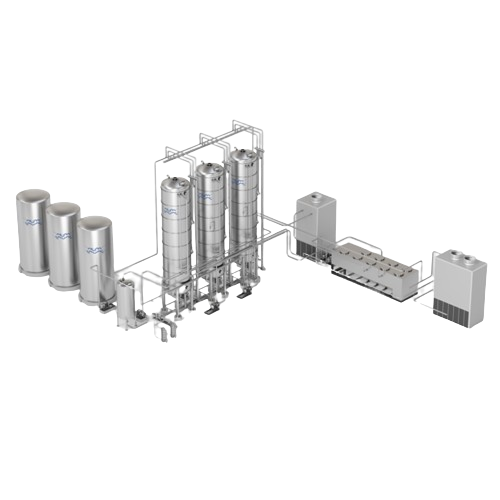Fat modification process systems
Enhance your production line with seamless fat modification and separation processes, tailored for creating specialty fats with precise melting points and properties without chemical alterations.

Enables Efficient Fat Fractionation and Modification
The DualFrac System from Alfa Laval is a versatile and efficient solution for palm oil refiners and specialty fat producers looking to optimize fat modification processes. This system allows seamless switching between continuous and batch dry fractionation, providing flexibility in meeting various product specifications, including high iodine value palm olein for cooking and solid palm stearin for margarine production.
The DualFrac system operates by initially pre-cooling palm oil with plate heat exchangers before it enters crystallizers. This pre-cooling stage enhances energy efficiency and reduces cycle times. Continuous transfer pumps are used to move oil between crystallizers and buffer tanks, cutting the required processing time and lowering energy consumption by up to 40% compared to traditional batch processes.
Designed for scalability and integration with upstream refineries, the system supports both semi-continuous and fully automated operations. Users can remotely monitor and control processes via an integrated PLC system, allowing for precise adjustments and ensuring consistent product quality. Common applications include bakery margarines, butter substitutes, and specialty confectionery fats, with customization options available for different material needs and processing capacities.
Meeting the demands of the food and edible oil industries, DualFrac offers enhanced energy efficiency and product quality while minimizing hydrogen and catalyst consumption, making it a reliable choice for modern fat modification requirements.
Benefits
- Increases production flexibility by offering seamless switching between continuous and batch processes.
- Reduces energy consumption by up to 40% through efficient pre-cooling and continuous transfer.
- Ensures consistent product quality with precise PLC-controlled monitoring and adjustments.
- Lowers production costs by optimizing hydrogen and catalyst use.
- Supports a wide range of specialty fat products, aligning with industry demands.
- Applications
- Shortening, Palm stearin, Food industry fats, Palm olein, Specialty fats, Edible oils, Margarine, Palm oil products
- End products
- Palm olein for cooking, Palm stearin for margarine, Butter substitutes, Specialty fats for confectionery, Culinary fats for food industry, Refined palm oil for food, Vegetable shortening, Bakery margarines
- Steps before
- Feedstock preparation, Heating, Buffer tank storage, Mixing, Vacuum drying
- Steps after
- Storage, Post-treatment, Bleaching, Deactivation with acid or water, Dehydration
- Input ingredients
- refined oils, palm oil, animal fats, unsaturated oils, different oils and fats, raw materials, feedstock
- Output ingredients
- specialty fats, margarine, shortening, palm olein, palm stearin, hard fats, liquid oils, products with different melting points, products with higher IV values, consistent oils or fats
- Market info
- Alfa Laval is renowned for its expertise in heat transfer, separation, and fluid handling technologies, providing innovative, energy-efficient engineered-to-order solutions for various industries including food, marine, and energy.
- Automation
- Fully automatic, PLC-controlled
- Cooling Temperature
- 65°C (initial heating for dry fractionation)
- Energy Efficiency
- Lowest production costs in terms of energy
- Filtration Type
- Membrane filtration system
- Hydrogenation Temperature
- 150–200°C
- Oleaginyield
- Higher yield in continuous dry fractionation
- Process flexibility
- Unlimited flexibility to produce various fats
- Steam Consumption Reduction
- Up to 40% in continuous dry fractionation
- Temperature Regulation
- Precisely controlled process in fractionation
- Water and Energy Usage
- Minimal usage
- Working mechanism
- Hydrogenation / Interesterification / Fractionation
- Integration
- Standalone or integrated with upstream refinery
- Batch vs. continuous operation
- Batch / Continuous
- Automation level
- PLC / Fully automatic
- Energy efficiency
- Low energy, hydrogen, and catalyst consumption
- Process flexibility
- Flexibility to produce various fats and handle different raw materials
- Environmental impact
- Minimal use of water and energy
- Phase control
- Crystallization process
- Cooling method
- Plate heat exchanger / External cooling
- Changeover flexibility
- Switch between continuous and batch fractionation
- Density/particle size
- 0.5–2.5 g/cm³ / 50–1000 µm
- Compact footprint
- Optimized for minimal space usage
- Control panel type
- Fully automatic, PLC-controlled
- Discharge method
- Membrane filtration system
- Shape and size
- Batch-type and continuous options
- Tank shape and size
- Crystallizers and buffer tank configuration
- Control panel type
- PLC-controlled
- Batch vs. continuous operation
- Switchable between batch and continuous
- Cooling method
- Plate heat exchanger
- Discharge method
- Membrane filtration system
- Energy efficiency
- Low energy consumption
